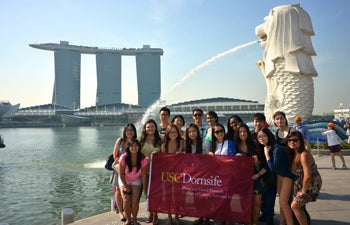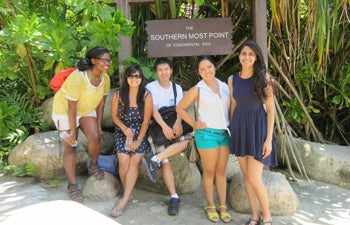The View From Southeast Asia
As political and economic focus shifts from Europe and the West toward the emerging powers of the East, the 21st century is being dubbed “America’s Pacific Century.”
However, the United States position on the dynamic region of Southeast Asia is anything but clear and questions abound. How is U.S. foreign policy shaping up after the 2012 presidential election? How does China’s new leadership see its role in Southeast Asia? And how do Southeast Asian leaders and analysts view prospects for regional stability?
A new Maymester course took 14 USC Dornsife undergraduates to Singapore to find the answers to these and other questions by talking to two dozen of the region’s leading policymakers, analysts and scholars. Titled “America’s Pacific Century: Dialogues Between the United States and Asia,” the month-long course was led by Saori Katada, associate professor and graduate director of international relations at USC Dornsife.
“Overseas trips like this are so important because they provide an opportunity to make students’ academic learning real,” Katada said. “They allow students to connect with the people, the place and the project being studied, and allow students to take ownership of what they are learning in a way that is tangible and personal.”
Jennifer Mo, a junior majoring in business administration with an international relations minor, agreed.
“It’s one thing to read textbooks and articles in a classroom, but it’s a completely different experience interacting with scholars and diplomats face-to-face,” she said, describing the trip as “a once in a lifetime opportunity.”
Katada devised the course with James Tang, professor of political science and dean of the School of Social Sciences at Singapore Management University (SMU).
“He got interested in Maymester when he visited us two years ago and suggested it might be a good idea to do an exchange,” she said.
“We agreed on the importance of basing the course around an interesting and unique teaching and learning experience, including exchange, peer-to-peer and active learning and the student creation of an original policy recommendation.”
Students attended four preparation classes in which they wrote analyses of the political policies of the various countries involved and learned about the Association of South East Asian Nations (ASEAN).
The course kicked off on May 20, when seven SMU students arrived at USC to spend a week in Los Angeles conducting interviews and participating in workshops where they presented their findings to their USC counterparts.
On May 30, the USC Dornsife undergraduates left L.A. for Singapore.

USC Dornsife undergrads visit Singapore’s iconic Merlion with Saori Katada, professor of international relations (sixth from left). In the background is the Marina Bay Sands, a shopping center, hotel and casino. Photo courtesy of Vivian Wu.
Divided into groups, the students examined four themes: political/diplomatic including military security, economic, non-traditional security (which includes issues such as environment, drugs, human trafficking, disaster relief) and social/cultural issues to create a 50-page task force report.
On an academic level, Katada said the students learned how to conduct independent research by developing highly focused and targeted interviews with analysts, policy-makers and scholars. They were also honored with a visit from the former president of Singapore, S. R. Nathan, who spoke about Southeast Asian relations with the U.S.
The highlight of the course came when the students presented their policy recommendations on how to improve Southeast Asia relations to the Second Obama administration before a full house at the American Chamber of Commerce in Singapore.
“James and I were very proud to see the students articulately outline their analyses and recommendations, and to successfully field questions from the audience and expert panelists,” Katada said. “It was an intense experience for the students, but I think they were also pretty proud of being able to pull that off.”
An edited and bound final version of the students’ findings will be sent to all those interviewed for the project as well as SMU participants and faculty. Katada is also planning to send a copy to the White House. “We may have some policy impact,” she said.
Katada paid tribute to the students’ efforts.
“They all worked very hard and very well together,” she said. “The group dynamics among the students was wonderful and created this tremendous commitment to the project. They were really engaged because of the way the course was structured and the fact that they had ownership of their work.”
Katada also credited the importance of peer-to-peer learning in the students’ steep learning curve and paid tribute to the SMU students.
“The Singaporean students were magnificent. Not only are they smart, articulate and very knowledgeable about the region, they were also very generous with their time both in showing our students around in Singapore and in sharing their ideas and knowledge.”
Jingwen Zhou, a senior majoring in international relations, global business, agreed.
“We formed very close bonds with the local students and were able to communicate with them on various topics,” she said. “The course gave us a wonderful opportunity to make friends while enabling us to do more efficient research.”
The trip wasn’t all work and no play, however. Exploring Singapore in their free time, students visited the city’s acclaimed Night Safari, the world’s first nocturnal zoo. Set in a humid tropical forest, it allows over 1,000 animals, including many rare and endangered species, to be viewed in their nocturnal habitat.
At Gardens by the Bay, the group toured two giant conservatories, the Flower Dome and the Cloud Forest, which features a tropical garden with a 115-foot-high waterfall.
“From any part of the country you can enjoy amazing views of landmarks like the Marina Bay Sands Hotel, the Flower Dome and Cloud Forest, the Merlions and the Espionage,” said Mo.
Students enjoyed sampling exotic Singaporean cuisine with its many international influences at the city’s hawker centers with their dozens of tiny food stands selling Malay, Thai, Chinese, Indian and Middle Eastern dishes.

Five participants in the USC Dornsife Maymester trip pose on Singapore’s popular island resort of Sentosa. From left, Alexis Montgomery, Jennifer Mo, Jason Tse, Kimberly Hernandez, and Dhwani Thapar. Photo courtesy of Jennifer Mo.
“I’m a foodie, so having internationally famous chili crab at Jumbo Seafood at Clarke Quay was a personal highlight,” said Alexis Montgomery, a junior majoring in international relations global business with a minor in psychology and law.
Montgomery also took the plunge and tried one of Singapore’s celebrated fish pedicures in which dozens of tiny toothless carp known as garra rufa, or doctor fish, nibbled the dead skin from her toes and feet to leave them baby soft.
The USC Dornsife students were surprised by the extent of Singapore’s multi-culturalism. They were also impressed with the city’s low crime rates and advanced infrastructure and technology, including its dramatic modern architecture and clean, efficient transport system. “It’s a beautiful city, a city of the future,” Mo said.
“Singapore is a very exciting place to visit,” Katada said. “Our students were able to get a sense of the rising Asia and experience firsthand why Asians are so proud of their progress and achievement.”
Each student benefited from a $1,000 grant from Student Opportunities for Academic Research (SOAR) provided by USC Dornsife.
“It helped our students significantly to have this financial support and enabled some of them who otherwise might not have been able to participate to do so,” Katada said.
“This was such a unique and rewarding experience for the students — the trip really exceeded our expectations,” she said. “They learned the substance of U.S. presence in and its foreign policy toward Southeast Asia from two dozen premier experts on the subject. And they deepened their understanding through peer-to-peer learning. This was active learning at its finest.
“I believe that the strong bonds created between the USC and SMU students during their shared experience from the course will last a lifetime and will contribute to a genuine bridge across the Pacific.”